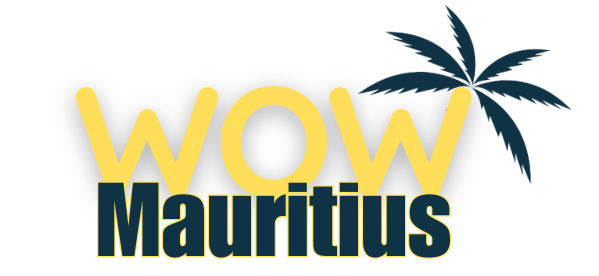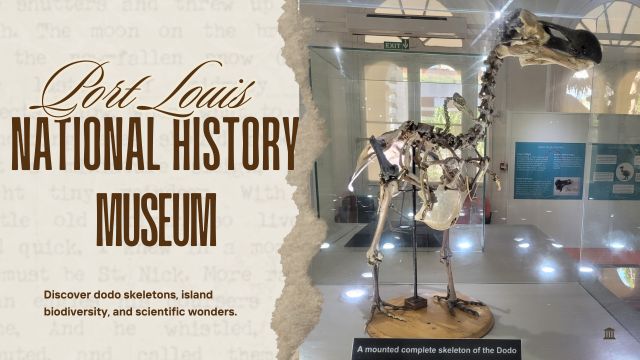If there’s one place in Mauritius where science, history, and storytelling come together in a quietly powerful way, it’s the National History Museum in Port Louis. Tucked away on Chaussée Street, just a few minutes’ walk from the Central Market, this elegant colonial-era building may not shout for attention, but once you step inside, you’re transported into a vivid world of extinct birds, volcanic islands, coral reefs, and evolutionary wonder.
The museum is housed in the historic Mauritius Institute building, completed in the early 1880s. Its white façade, tall shuttered windows, and veranda-lined walls reflect a blend of British civic design and island adaptation. For over a century, it has quietly held one of Mauritius’s most iconic and important scientific collections, especially those connected to the island’s most famous former resident, the dodo.
The Dodo’s Quiet Comeback
Everyone knows the dodo. Or at least, they think they do. It’s the bird the world loves to use as a metaphor for obsolescence, extinction, and failure. But what the National History Museum does best is turn that idea on its head.
As you enter the main gallery, the first thing that catches your eye is the nearly complete dodo skeleton, one of only two in the world made entirely from the bones of a single individual. It was discovered in 1904 by Etienne Thirioux, a self-taught Mauritian naturalist who spent years collecting and studying the fossils of extinct birds. This skeleton is the pride of the museum, and for good reason. It tells a more accurate story of what the dodo actually was.
Recent studies using CT scans, laser imaging, and 3D reconstructions reveal that the dodo wasn’t the slow, clumsy creature old drawings make it out to be. It was a ground-dwelling forest bird, fast and muscular, with strong legs adapted to running through dense undergrowth. Its large beak wasn’t for show either, it likely helped it crack open hard fruits and defend its territory. In fact, isotopic testing of dodo bones even shows that it had a varied diet, including fruit, seeds, and possibly small land crabs.
The museum gives you that full picture. Instead of just displaying dusty bones, it offers context. You learn about the dodo’s origins, how its ancestors likely flew in from Southeast Asia millions of years ago, and how isolation on a predator-free island allowed it to evolve into the flightless bird we now recognize. The museum doesn’t shy away from the tragic part of the story either. Within just a few decades of human arrival on Mauritius, the dodo population was decimated by hunting, habitat destruction, and invasive species like rats, pigs, and monkeys that ate their eggs.
But there’s hope, too. The story of the dodo is not just about loss. It’s about what we’ve learned from that loss. The museum partners with local conservation groups to protect remaining endemic species like the Mauritius kestrel, pink pigeon, and echo parakeet. These success stories are featured throughout the exhibits, and they remind visitors that extinction is not inevitable. It’s preventable, if we choose to act.
More Than Just a Dodo Museum
Although the dodo gets most of the spotlight, the National History Museum is far from a one-bird show. The other galleries offer a fascinating cross-section of Mauritian wildlife, geology, and ecology. You’ll find preserved specimens of reptiles, insects, fish, and birds, both extinct and still surviving.
A particularly interesting section is dedicated to marine life. Here, coral structures and preserved pelagic species tell the story of Mauritius’s vibrant underwater world. A life-sized model of a coelacanth (a rare deep-sea fish) sits under soft lighting, giving you a sense of the biodiversity that surrounds the island beneath the waves.
The geology corner is also worth a pause. It traces the volcanic origins of Mauritius, with examples of basalt, lava tubes, and explanations of how the island chain formed. A small meteorology section rounds things off with an overview of the local climate and the trade winds that shape everyday life on the island.
The museum also includes a reading room filled with old monographs, books, and reports. Some date back over a hundred years. These are available for public reference and are often used by researchers from both Mauritius and abroad. The museum’s upper floor occasionally hosts temporary exhibits, but the main draw remains its carefully curated permanent collection downstairs.
Visiting the National History Museum
Despite its importance, the National History Museum remains accessible and welcoming. Entry is free for most of the year, and even during special exhibitions, the fee is usually just a few rupees. The staff are helpful, and there’s a small kiosk at the entrance where you can pick up souvenirs like miniature dodos, postcards, or locally published nature guides.
The museum is open Monday, Tuesday, Thursday, and Friday from 9am to 4pm. On Wednesdays, it opens at 11am, and on Saturdays, it runs until noon. It’s closed on Sundays and public holidays. The galleries on the ground floor are wheelchair accessible, though the upstairs areas require stair access.
Located right in the heart of Port Louis, the museum is easy to pair with a morning at the Central Market or a walk through the historic Government House district. It’s also a great indoor option if you’re visiting on a rainy day or simply want a quiet place to escape the midday sun.
In many ways, the National History Museum is a reflection of Mauritius itself. Modest in appearance, rich in history, deeply layered, and constantly evolving. It invites you to slow down, to observe, to question, and to understand that even in a small room with old bones and faded maps, you can find the future.
Whether you’re traveling with kids, interested in conservation, or simply curious about the dodo’s true story, this museum is one of the most meaningful places you can visit on the island.



